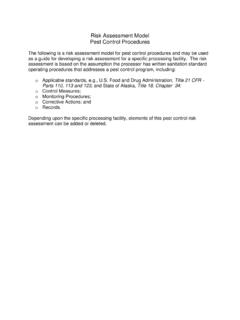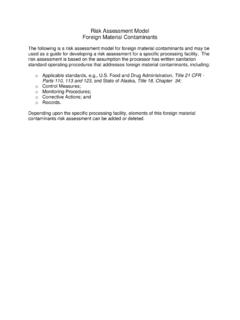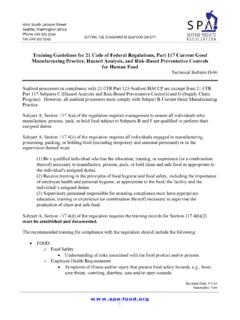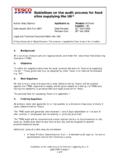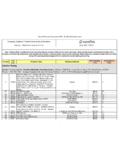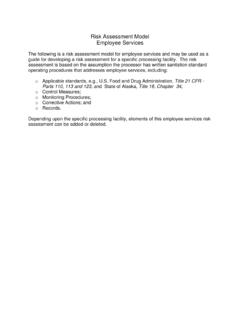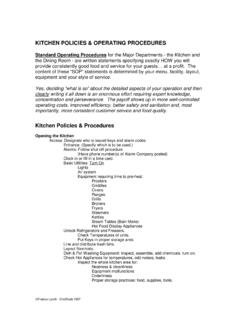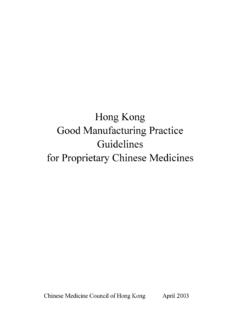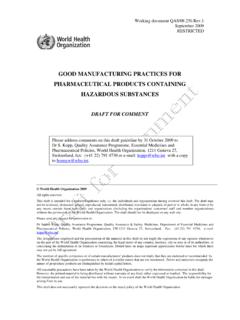Transcription of Food Manufacturing Standard
1 food Manufacturing Standard Author: Mary Salmon Applicable to: Product: All food Country: Group Date Issued: 28th Nov 2007 Date Revised: 25th Feb 2008 Revision Due: 25th Feb 2009 Legal and Technical Document Matrix No: 347 Tesco Stores Ltd. All Rights Reserved. This document is supplied by Tesco for use of the immediate recipient food Manufacturing Standard TESCO food Manufacturing Standard Version February 2008 Page 1 of 125 TESCO food Manufacturing Standard CONTENTS Introduction to the Tesco food Manufacturing Standard Site Audit Section 1 HACCP 2 finished Product Specifications 3 Raw Material and Secondary Site Management 4 Packaging 5 External Areas and Site Security 6 Design and Construction of Premises 7 Design and Construction of Equipment 8 Employee Facilities and Personal Protective Equipment 9 Factory Hygiene 10 Personal Hygiene 11 Process Controls 12 Traceability 13 Allergen Control 14 Foreign Body Controls 15
2 Foreign Body Detection 16 Product Inspection and Analysis 17 Water and Waste Water Management 18 Product Labelling and Coding 19 Weight, Volume and Count Checks 20 Training Quality Systems Audit 21 Quality Management System 22 Product Development 23 Product Recall/Incident Management 24 Internal Audits 25 Customer Complaints 26 Pest Control 27 Maintenance 28 Calibration 29 Cleaning Programme 30 Transport 31 Medical Screening 32 Employment Agencies 33 Environment 34 Ethical Trading Appendix 1 Raw Material Specifications Appendix 2 Document Review Glossary TESCO food Manufacturing Standard Version February 2008 Page 2 of 125 TESCO food Manufacturing Standard Introduction to the Tesco food Manufacturing Standard Aim Tesco is committed to ensuring products produced by suppliers are safe.
3 Meet legal requirements and are of the agreed quality and that the working conditions of people at Tesco suppliers and ethics applied meet or exceed relevant standards . Objective The Tesco food Manufacturing Standard (TFMS) sets out the requirements to which suppliers must comply. In some product areas there are additional requirements as detailed in codes of practice. In no circumstances does compliance to the Standard replace the need for compliance to relevant legal standards in the country of manufacture or the intended country of sale. Compliance to the Standard is in addition to the duty held by the supplier to produce safe and legal food . Scope The TFMS applies to all primary and secondary food suppliers to Tesco.
4 The Standard Structure The Sections and Layout The Standard documents Tesco requirements for the Good Manufacturing Practice for food . It is divided into sections by subject, which are then sub divided further to help identify the detailed requirements. Base, Medium, High, Aspiration Each requirement has been allocated a level of Base, Medium, High or Aspiration. These annotations relate to the type of product and or processing which are covered by each requirement. Base These requirements are required in all production facilities irrelevant of the product or process type. Medium These requirements are required in open food handling areas in addition to all of the Base requirements. High TESCO food Manufacturing Standard Version February 2008 Page 3 of 125 TESCO food Manufacturing Standard These requirements are required in all areas that are identified as handling or processing high risk or high care products in addition to all the Base and Medium requirements.
5 Application of Base/Medium/High In a site Manufacturing a High Risk product all requirements of the Standard (Base, Medium and High) will apply. in the high risk area the requirements specified as High apply (in addition to the Base and Medium), in a raw open food area the Medium requirements apply (in addition to Base) and in an area where there is no open product storage areas, Base requirements apply. Base Raw Material & Packaging Storage Base Despatch Areas High High Risk/ High Care Medium Open food Areas Preparation Areas Additional Examples Produce Base = Whole produce whole carrots or swede (including minor trimming) Medium = Prepared produce which is no longer whole ready to cook carrot batons or vegetable medley High = Prepared ready to eat produce ready to eat carrot sticks or fruit salad Enclosed Systems Base = Enclosed system areas pipework Medium = Areas where the product is exposed tanks where product is accessible.
6 Aspiration Some items have detailed requirements at Base, Medium or High levels but also have some additional elements which Tesco believe will help move standards forward within the food supply base. These are not prescribed requirements but will be viewed favourably by Tesco if implemented. What Good Looks Like In many sections examples are given of how a requirement may be met under the heading of What Good Looks Like. This is intended to provide guidance and clarification of what is required. Due to the variability of the processes and premises compliance to What Good Looks Like does not ensure compliance to a requirement. The supplier must determine the most effective method of complying with Tesco requirements.
7 TESCO food Manufacturing Standard Version February 2008 Page 4 of 125 TESCO food Manufacturing Standard TESCO food Manufacturing Standard Version February 2008 Page 5 of 125 PRO To help identify how the requirements should be met each is identified by an x under columns headed PRO. These columns indicate whether the requirement is met through a fully implemented documented procedure, documented records or simple observations. This avoids the need to qualify each requirement with the comment of Documented procedures are required, records must be kept etc. Review The contents of the Standard will be regularly reviewed and amended as required. Glossary A glossary has been provided to help with understanding.
8 TESCO food Manufacturing Standard Section 1 HACCP P R O SectionNo. Base Medium High Aspiration Item Detail 99 What Good Looks Like x x B HACCP Plan The HACCP Plan must be developed using Codex Alimentarius HACCP principles with reference to relevant legislation, Tesco Codes of Practice and industry guidance. The HACCP Plan must include a detailed scope referencing elements of sections , , , x x B HACCP Team The HACCP system should be developed by a multi-disciplinary team which must have product specific knowledge and expertise. If expertise is not available, expert advice may be obtained from other sources. The operation of the HACCP system must remain the responsibility of the site.
9 At least one member of the team must have completed a recognised qualification (minimum Intermediate HACCP or equivalent) and the other members must be suitably trained. x x B Pre-requisites The basic environmental and operating conditions that are required for the production of safe and legal food must be in place. This covers good Manufacturing practices throughout the site. They may include : Pest control Cleaning procedures Glass/hard plastic control The control measures and monitoring procedures for the pre-requisites are clearly identified and documented. TESCO food Manufacturing Standard Version February 2008 Page 6 of 125 TESCO food Manufacturing Standard Waste control x B Product A full description of the product must be documented including relevant safety information : Composition Origin of ingredients Physical or chemical structure (including Aw, pH etc.)
10 Treatment and processing ( heating, freezing, salting) Packaging ( modified atmosphere, vacuum) Storage and distribution conditions ( with specified temperatures) Durability and required shelf-life Instructions for use x B Intended Use The intended use of the product must be defined, detailing the end user or consumer and suitability for vulnerable groups must be considered infants, elderly, and allergy sufferers. x x B Flow Diagram A flow diagram covering all steps in the operation including rework and waste must be constructed. This may be generic but it is critical that all process steps are included and identified by product. The diagram must be verified within the production area.
